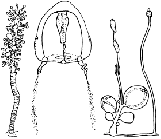WoRMS taxon details
Zancleidae Russell, 1953
Corynipteridae Weill, 1934 · unaccepted (invalid name, not based on genus)
Halocorynidae Picard, 1957 · unaccepted > junior subjective synonym
Orthocorynidae A. Agassiz, 1865 · unaccepted (invalid name, not based on genus name)
- Genus Apatizanclea Maggioni, 2023
- Genus Halocoryne Hadzi, 1917
- Genus Zanclea Gegenbaur, 1857
- Genus Zanclella Boero & Hewitt, 1992
- Genus Acrochordium Meyen, 1834 accepted as Zanclea Gegenbaur, 1857 (name suppressed by the ICZN (1994), opinion 1752)
- Genus Gemellaria McCrady, 1859 accepted as Gemmaria McCrady, 1859 accepted as Zanclea Gegenbaur, 1857 (unaccepted > misspelling - incorrect subsequent spelling, synonym)
- Genus Gemmaria McCrady, 1859 accepted as Zanclea Gegenbaur, 1857 (unaccepted > junior subjective synonym)
- Genus Guentherella Weill, 1934 accepted as Zanclea Gegenbaur, 1857 (synonym)
- Genus Gymnocoryne Hincks, 1871 accepted as Zanclea Gegenbaur, 1857 (synonym)
- Genus Halocharis L. Agassiz, 1862 accepted as Zanclea Gegenbaur, 1857 (synonym)
- Genus Mnestra Krohn, 1853 accepted as Zanclea Gegenbaur, 1857 (name suppressed by the ICZN (1994), opinion 1752)
- Genus Zanklea Gegenbaur, 1857 accepted as Zanclea Gegenbaur, 1857 (unaccepted > misspelling - incorrect subsequent spelling, misspelling)
- Genus Ctenaria Haeckel, 1879 (uncertain > taxon inquirendum)
marine, fresh, terrestrial
Russell, F.S., 1953. The medusae of the British Isles. Anthomedusae, Leptomedusae, Limnomedusae, Trachymedusae and Narcomedusae. : 1-530, pls. 1-35.
page(s): 98 [details] Available for editors [request]
[request]
page(s): 98 [details] Available for editors
Schuchert, P.; Choong, H.; Galea, H.; Hoeksema, B.; Lindsay, D.; Manko, M.; Pica, D. (2025). World Hydrozoa Database. Zancleidae Russell, 1953. Accessed through: World Register of Marine Species at: https://www.marinespecies.org/aphia.php?p=taxdetails&id=22781 on 2025-07-18
![]() The webpage text is licensed under a Creative Commons
Attribution 4.0 License
The webpage text is licensed under a Creative Commons
Attribution 4.0 License
Nomenclature
original description
Russell, F.S., 1953. The medusae of the British Isles. Anthomedusae, Leptomedusae, Limnomedusae, Trachymedusae and Narcomedusae. : 1-530, pls. 1-35.
page(s): 98 [details] Available for editors [request]
[request]
original description (of Orthocorynidae A. Agassiz, 1865) Agassiz, A. (1865). North American Acalephae. <em>Illustrated Catalogue of the Museum of Comparative Zoölogy at Harvard College.</em> 2: 1-234., available online at http://www.biodiversitylibrary.org/bibliography/1837 [details]
original description (of Halocorynidae Picard, 1957) Picard, J. (1957). Étude sur les hydroïdes de la superfamille Pteronematoidea, 1. Généralités. <em>Bulletin de l'institut Océanographique.</em> 1106 : 1-12. [details]
basis of record Bouillon, J.; Boero, F. (2000). Synopsis of the families and genera of the Hydromedusae of the world, with a list of the worldwide species. <i>Thalassia Salent. 24</i>: 47-296 (look up in IMIS) [details]
page(s): 98 [details] Available for editors
original description (of Orthocorynidae A. Agassiz, 1865) Agassiz, A. (1865). North American Acalephae. <em>Illustrated Catalogue of the Museum of Comparative Zoölogy at Harvard College.</em> 2: 1-234., available online at http://www.biodiversitylibrary.org/bibliography/1837 [details]
original description (of Halocorynidae Picard, 1957) Picard, J. (1957). Étude sur les hydroïdes de la superfamille Pteronematoidea, 1. Généralités. <em>Bulletin de l'institut Océanographique.</em> 1106 : 1-12. [details]
basis of record Bouillon, J.; Boero, F. (2000). Synopsis of the families and genera of the Hydromedusae of the world, with a list of the worldwide species. <i>Thalassia Salent. 24</i>: 47-296 (look up in IMIS) [details]
Other
From editor or global species database
Diagnosis Hydroids colonial, polyps issued from creeping stolons, sessile or with usually unbranched pedicel; polyps monomorphic or polymorphic; gastrozooids either with oral and aboral capitate tentacles, or with reduced capitate tentacles, or without tentacles; gonozooids and dactylozooids, when present, with capitate tentacles or these reduced to variable degrees. Perisarc enveloping hydranth pedicels and stolons a simple tube and not lamellar.Medusa umbrella bell-shaped; four perradial exumbrellar nematocyst patches, these either oval, clavate, elongate or linear, usually containing stenoteles; mouth simple, circular, without oral tentacles; gonads usually as interradial pads on manubrium, rarely in a single mass encircling manubrium; four radial canals; marginal tentacles 0, 2 or 4, hollow, when present with numerous, long, stalked nematocytes (cnidophores) containing macrobasic euryteles; without ocelli.
[details]
| Language | Name | |
|---|---|---|
| Japanese | スズフリクラゲ科 | [details] |

